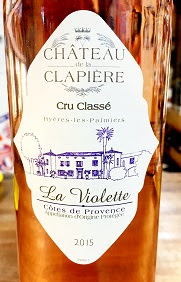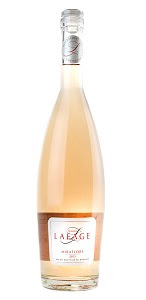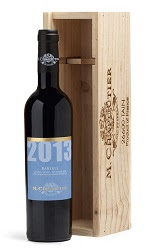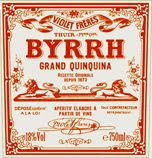June 24, 2016
Bonjour Mes Amis,
We’re very happy to introduce three new cheeses, this week, at Paris Grocery.
Le Somport Fermier $24.99/lb
A farmstead Tomme made from raw cow’s milk in the mountainous Basque Pyrenees of France. This semi-soft cheese is aged for five months. Mild and creamy with delicate mushroom notes and a long hazelnut finish. Truly TASTY! Pairs well with a Basque Irouleguy red wine.
2011 Brana Ohitza Irouleguy Rouge $26.99
This is an incredible, full-bodied, but not massive, red wine that’s driven by tannins and black fruits. Lots of character and flavor here with mineral, game meat, fresh thyme, rosemary, and mint, as well as dark chocolate, black cherry, plum and blackcurrant.
Tomme Corse Brebis $31.99/lb
We love Tomme Corse Chevre, and now we carry itsbrebis counterpart. This Tomme is made from pasteurized sheep’s milk on the island of Corsica. Rich, savory, and slightly salty with a peppery tang. Described to us by our French cheesemonger as “à mourir d’envie”, a cheese to die for. Pair this Tomme with a Corsican red.
2010 Domaine Maestracci ‘E Prove’ Corse Calvi $17.99
“Something about its tannin, black fruit, herbs, and spices makes it almost as fundamental as olive oil at any Mediterranean meal.” – Kermit Lynch.
“Schlossberger” Cave Aged Gruyère $27.99/lb
Schlossberger Gruyère is made from unpasteurized cow’s milk, and aged in caves near the Schlossberg castle in Switzerland. After its aging period of 18 months, bits of salt crystal begin to form, giving the cheese a pleasant crunch. A firm and creamy gruyère, with butter, herb, and hazelnut notes.
Wines
From time to time we like to shine a spotlight on outstanding wineries and winemakers. There are only a handful of truly worthy Muscadet producers, and Domaine de la Pépière is most certainly one of the greats. Marc Ollivier has more than done his fair share in insuring Muscadet’s meteoric rise to the top. His insistence on clean vineyard practices in a region where that can be very difficult, as well as concentration on single terroir bottlings, has set a quality standard for Muscadet that is very high.
Domaine de la Pépière
http://www.domainedelapepiere.com/english/index_en.php
 When Marc Ollivier is on, these are the top wines of the AOC – wines that are not only delicious young, but that can also age 10, 20 or 30 years. Ollivier’s Muscadet-sur-Lie is the authentic item — it has lees contact until the time of bottling, generally in late May. This extended contact gives it the crispness that makes Muscadet so refreshing, and the classic wine match for seafood. It is the traditional way to make Muscadet, but has become the exception as growers and shippers rush to bottle “technically correct” wines by early January.
When Marc Ollivier is on, these are the top wines of the AOC – wines that are not only delicious young, but that can also age 10, 20 or 30 years. Ollivier’s Muscadet-sur-Lie is the authentic item — it has lees contact until the time of bottling, generally in late May. This extended contact gives it the crispness that makes Muscadet so refreshing, and the classic wine match for seafood. It is the traditional way to make Muscadet, but has become the exception as growers and shippers rush to bottle “technically correct” wines by early January.
In this rush to bottle, Muscadet producers use special “starter” yeasts (which often also add flavors and aromas) to accelerate fermentation and enzymes or other techniques to finish the wine early. Sterile filtration is in rampant use. Ollivier takes his time. He hand harvests (also a rarity in the region), uses natural yeasts, waits for the wine to finish and bottles with a very light filtration. The vineyards are in old vines (40 years and older) with a particularly good exposition on a plateau overlooking the river Sèvre. All the vineyards are from original stock: Ollivier is the only grower in the Muscadet who does not have a single clonal selection in his vineyards.
The vinification techniques are traditional for the area: no skin maceration but direct pressing within 2 hours of picking, racking of the must after 12 hours to remove the solid matter, and controlled temperatures, not to exceed 71.6 degrees F, for the fermentation. The aging of the wine, on its lees in stainless steel vats, lasts until bottling, about eight months later.
–Notes adapted from the Louis Dressner website, Domaine de la Pépière’s importer.
2014 Domaine de la Pépière  Muscadet Sévre et Maine sur Lie $13.99
Muscadet Sévre et Maine sur Lie $13.99
The white labeled regular 2014 Muscadet des Sèvre et Maine “sur lie” has a yeasty aroma of fully ripe yellow-fleshed fruits mixed with citrus flavors. It is a medium-bodied and minerally structured, fresh and salty Muscadet of great purity with a good aftertaste. It’s already drinkable, but can age for ten years or more, although it should be consumed sooner rather than later, due to its attractive fruit and vibrancy.
2013 Domaine de la Pépière ‘Clisson’ Muscadet Sévre et Maine $22.99
One of Ollivier’s most famous bottlings, Clisson is largely a granitic site that has been recognized for its unique terroir. Clisson produces a tightly knit, mineral driven Melon de Bourgogne that while delicious when young, can be a revelation when allowed to age for a few years.
“A remarkable, high-toned nose of pear, peach, almond extract, basswood (a.k.a. linden, a.k.a. tillieul), and pungent citrus oils and buckwheat leads to a palate of subtly oily texture; expansive richness and northerly orchard fruit ripeness unexpected from Muscadet; as well as deep saline, and crustacean minerality. Piquant nuttiness, sizzling citrus oil, and licks of salt offer counterpoint to the fruit in a finish of vibratory intensity.” – Wine Advocate.
2013 Domaine de la Pépière ‘Monnières-Saint Fiacre’ Muscadet Sévre et Maine $22.99
This is a new labeling for Pepière, but Ollivier has worked this vineyard for some time now- these grapes previously went into his ‘Gras Moutons’ bottling. Monnières-Saint Fiacre was recently recognized as part of the “cru communaux” system which includes 9 different vineyards, all with with special terroirs and qualities. The Monnières-Saint Fiacre is softer and more creamy than the Clisson Muscadet, and perhaps a better candidate for early drinking, although there is no doubt this will age more than gracefully.
Note: Paris grocery also regularly stocks the superb Domaine de La Pépière ‘Clos de Briords’ Muscadet, when available. $18.99
A Bientôt!
Kelsey & Manuel
 has long been part of the Francophone world, and as such, has had an influence on French cuisine and food tastes. Perhaps, the most popular has been the one-pot, slow-cooking method employed by Morrocans and Tunisians that utilize the famous tagine vessel. Tagines are rich and aromatic casseroles that form, particularly, the basis of traditional Moroccan cooking. Flavored with fragrant spices, they are cooked and often served from an attractive lidded cooking vessel, also called a tagine. Here at Paris Grocery, we are proud to carry a broad selection of tagines from Le Souk (Tunisia), Emile Henri (France), and Graupera (Spain). Stop by and check out these beautiful, utilitarian cooking vessels, and discover the savory world of tagine.
has long been part of the Francophone world, and as such, has had an influence on French cuisine and food tastes. Perhaps, the most popular has been the one-pot, slow-cooking method employed by Morrocans and Tunisians that utilize the famous tagine vessel. Tagines are rich and aromatic casseroles that form, particularly, the basis of traditional Moroccan cooking. Flavored with fragrant spices, they are cooked and often served from an attractive lidded cooking vessel, also called a tagine. Here at Paris Grocery, we are proud to carry a broad selection of tagines from Le Souk (Tunisia), Emile Henri (France), and Graupera (Spain). Stop by and check out these beautiful, utilitarian cooking vessels, and discover the savory world of tagine. Preserved Lemon $12.99
Preserved Lemon $12.99

 minutes. Carefully place the kefta in the liquid, cover and poach for about 15 minutes, rolling them in the liquid from time to time so they are cooked well on all sides. Pour over the lemon juice, season the liquid with salt and tuck the lemon segments around the kefta. Poach for a further 10 minutes.
minutes. Carefully place the kefta in the liquid, cover and poach for about 15 minutes, rolling them in the liquid from time to time so they are cooked well on all sides. Pour over the lemon juice, season the liquid with salt and tuck the lemon segments around the kefta. Poach for a further 10 minutes.
 Expand your knowledge of fromage with this seasonal cheese cookbook by authors Alex and Leo Guarneri. ‘A year in cheese celebrates the pleasure of eating seasonally, with over 55 classic and inventive recipes using seasonal cheese. […] In this unique cookbook, the team at Androuet share their passion and knowledge with tips, recommendations and dishes for every time of year.’
Expand your knowledge of fromage with this seasonal cheese cookbook by authors Alex and Leo Guarneri. ‘A year in cheese celebrates the pleasure of eating seasonally, with over 55 classic and inventive recipes using seasonal cheese. […] In this unique cookbook, the team at Androuet share their passion and knowledge with tips, recommendations and dishes for every time of year.’

 week we are excited to start carrying local treats, King Caramel. Hedy Anderson, the ‘Queen’ of King Caramel, hand makes and hand wraps her caramels on Vashon Island, Washington. Sweet, soft, buttery, melt-in-your-mouth morsels that will make you want to sit back and savor their chewy deliciousness. We carry two exquisite flavors: Sea Salt and Black Licorice.
week we are excited to start carrying local treats, King Caramel. Hedy Anderson, the ‘Queen’ of King Caramel, hand makes and hand wraps her caramels on Vashon Island, Washington. Sweet, soft, buttery, melt-in-your-mouth morsels that will make you want to sit back and savor their chewy deliciousness. We carry two exquisite flavors: Sea Salt and Black Licorice.
 ologist, professional or amateur, would be caught without them in their arsenal of tricks, and tracking down exotic bitters can become a mild obsession. Did you know Paris Grocery stocks an impressive selection of bitters for all your cocktail needs? Whether it’s a bottle of orange bitters or something a tad more exotic, like say, Xocolatl Mole or Jamaican Blackstrap, this is the place to come for Fee Brothers, Scrappy’s, Peuychaud’s, Regan’s, and more. We also stock Jack Rudy Cocktail Co. cocktail cherries, tonic and small batch grenadine, as well as Amarena and Morello cheries from Italy and France. Look no further for bitters to add flair and a dash of spice to your latest creations!
ologist, professional or amateur, would be caught without them in their arsenal of tricks, and tracking down exotic bitters can become a mild obsession. Did you know Paris Grocery stocks an impressive selection of bitters for all your cocktail needs? Whether it’s a bottle of orange bitters or something a tad more exotic, like say, Xocolatl Mole or Jamaican Blackstrap, this is the place to come for Fee Brothers, Scrappy’s, Peuychaud’s, Regan’s, and more. We also stock Jack Rudy Cocktail Co. cocktail cherries, tonic and small batch grenadine, as well as Amarena and Morello cheries from Italy and France. Look no further for bitters to add flair and a dash of spice to your latest creations!


 make something so simple so magnificently délicieux. It is one of those special traditions I love most about French culture, and I like to recreate it when I am feeling wistful for France. Lucky for us French breakfast lovers, Paris Grocery now carries café bowls and egg cups! Soft boil an egg, top toast with your favorite confiture, wrap your hands around a bowl of freshly brewed coffee, and transport yourself to France with a leisurely French breakfast.
make something so simple so magnificently délicieux. It is one of those special traditions I love most about French culture, and I like to recreate it when I am feeling wistful for France. Lucky for us French breakfast lovers, Paris Grocery now carries café bowls and egg cups! Soft boil an egg, top toast with your favorite confiture, wrap your hands around a bowl of freshly brewed coffee, and transport yourself to France with a leisurely French breakfast.
 Caramel $2.99
Caramel $2.99
 much a family affair. Aimé’s son, Christophe, who received a technical diploma in viticulture and oenology in Beaune in 1991, and a further degree in marketing in Mâcon, returned to the domaine to take over day-to-day duties. By adding new cuvees, and developing new markets for his wines, the domaine saw an increase in the availability and renown of the estate. In 2001, Isabelle –Aimé’s daughter– graduated as an oenologist from the University of Toulouse, and joined the team. Today, the entire family is involved in the estate’s operations.
much a family affair. Aimé’s son, Christophe, who received a technical diploma in viticulture and oenology in Beaune in 1991, and a further degree in marketing in Mâcon, returned to the domaine to take over day-to-day duties. By adding new cuvees, and developing new markets for his wines, the domaine saw an increase in the availability and renown of the estate. In 2001, Isabelle –Aimé’s daughter– graduated as an oenologist from the University of Toulouse, and joined the team. Today, the entire family is involved in the estate’s operations. Châteauneuf-du-Pape ‘Chaupin’ 2012 $90.00
Châteauneuf-du-Pape ‘Chaupin’ 2012 $90.00

 Mobazillac ‘Les Pins’ 2013 $19.99 (500ml)
Mobazillac ‘Les Pins’ 2013 $19.99 (500ml)

 cluding 32 hectares of Cru, located in foothills of the Massive des Maures, at the crossroads of the fertile valleys of Sauvebonne and the Borrels, where the vines flourish among citrus and palm trees in a unique microclimate. The Chateau was designated as a Cru Classé rosé in 1955. The wine is an elegant blend of Grenache, Cinsault and Syrah, that offers an expressive nose brimming with fresh notes of raspberry, cherry, watermelon, and green tea. The palate is firm and focused, with generous acidity. Bright fruit notes are complemented by hints of sandalwood and mineral undertones. Highly recommended.
cluding 32 hectares of Cru, located in foothills of the Massive des Maures, at the crossroads of the fertile valleys of Sauvebonne and the Borrels, where the vines flourish among citrus and palm trees in a unique microclimate. The Chateau was designated as a Cru Classé rosé in 1955. The wine is an elegant blend of Grenache, Cinsault and Syrah, that offers an expressive nose brimming with fresh notes of raspberry, cherry, watermelon, and green tea. The palate is firm and focused, with generous acidity. Bright fruit notes are complemented by hints of sandalwood and mineral undertones. Highly recommended. 2015 Domaine Roumagnac Fronton Rosé ‘Authentique’ $14.99
2015 Domaine Roumagnac Fronton Rosé ‘Authentique’ $14.99
 keeping the butter at room temperature. Indispensable!
keeping the butter at room temperature. Indispensable! , and with everyone! The original version of the famous aperitif without alcohol! Just add five parts chilled water to one part of Pacific ‘Sensation Anis’–it’s that easy. Enjoy!
, and with everyone! The original version of the famous aperitif without alcohol! Just add five parts chilled water to one part of Pacific ‘Sensation Anis’–it’s that easy. Enjoy! Classé’ 2014 $26.99
Classé’ 2014 $26.99 natural, high-fired clay excels at retaining and distributing heat evenly, allowing you to bake your pie or brown your quiche to perfection. Emile Henry’s durable ceramic cookware is also freezer, oven, microwave, and dishwasher safe. What’s not to love!
natural, high-fired clay excels at retaining and distributing heat evenly, allowing you to bake your pie or brown your quiche to perfection. Emile Henry’s durable ceramic cookware is also freezer, oven, microwave, and dishwasher safe. What’s not to love! NV Albert Bichot Crémant de Bourgogne Brut Rosé $22.99
NV Albert Bichot Crémant de Bourgogne Brut Rosé $22.99 from Sweet Paris by Michael Paul $29.95
from Sweet Paris by Michael Paul $29.95 firmly in place, quickly flip upside down so that the pastry is underneath.
firmly in place, quickly flip upside down so that the pastry is underneath.
 speak it. In recent years, there has been a push by Catalan nationalists towards secession from the Languedoc and for greater autonomy for the region, including the revival of the Catalan language, and even the creation of a political entity, Catalunya Nord (Northern Catalonia), but this move seems to have minimal support. The arms of Roussillon, depicted in the lower half of the Languedoc-Roussillon-Midi-Pyrénées coat of arms, pictured right, is the Senyera, the flag of Catalunya, vertically disposed.
speak it. In recent years, there has been a push by Catalan nationalists towards secession from the Languedoc and for greater autonomy for the region, including the revival of the Catalan language, and even the creation of a political entity, Catalunya Nord (Northern Catalonia), but this move seems to have minimal support. The arms of Roussillon, depicted in the lower half of the Languedoc-Roussillon-Midi-Pyrénées coat of arms, pictured right, is the Senyera, the flag of Catalunya, vertically disposed. o combines a variety of ingredients that reflect the topography, that is,mer et montagne, the Mediterranean and the mountains. Ailes des poulet, langouste au citron et au gingembre, Chicken wings and spiny lobster, with lemon and ginger, or Mixed vegetables with mussels and blood sausage, Ollada de petits légumes aux moules et boudin noir, are typical of this kind of culinary thinking. The recipes can be found in Culinaria France, on sale at Paris grocery, $19.99.
o combines a variety of ingredients that reflect the topography, that is,mer et montagne, the Mediterranean and the mountains. Ailes des poulet, langouste au citron et au gingembre, Chicken wings and spiny lobster, with lemon and ginger, or Mixed vegetables with mussels and blood sausage, Ollada de petits légumes aux moules et boudin noir, are typical of this kind of culinary thinking. The recipes can be found in Culinaria France, on sale at Paris grocery, $19.99. ge on the finish.” —Wine Advocate
ge on the finish.” —Wine Advocate M. Chapoutier Banyuls 2013 (500ml) $24.99
M. Chapoutier Banyuls 2013 (500ml) $24.99 Quinquina $19.99
Quinquina $19.99